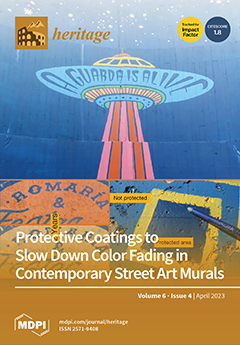Open AccessArticle
Preserving Intangible Heritage through Tangible Finds: The “Skull with Ears”—St. Luciella ai Librai’s Church (Naples, Italy)
by
Andrea Macchia, Stefania Montorsi, Giorgia Salatino, Romana Albini, Eugenio Cerilli, Chiara Biribicchi, Massimo Faella, Angela Rogliani, Tilde de Caro, Carmine Lubritto, Carmela Vetromile, Maria Rosa Di Cicco, Andrea Ambrosini and Alessandra Sperduti
Cited by 1 | Viewed by 2182
Abstract
The present study reports the conservative first aid concerning the human cranium known as the “Skull with Ears”, which is conserved in the crypt of Santa Luciella ai Librai’s church in Naples, Italy. These remains have historically been worshipped by devotees within the
[...] Read more.
The present study reports the conservative first aid concerning the human cranium known as the “Skull with Ears”, which is conserved in the crypt of Santa Luciella ai Librai’s church in Naples, Italy. These remains have historically been worshipped by devotees within the cult of the “abandoned souls”. The skulls were “adopted” by the Neapolitan population and treated with particular care in exchange for divine favors. The critical preservation status of the “Skull with ears” required a multidisciplinary approach aimed at defining the taphonomy and anthropological features of the cranium, while determining the state of its conservation by using a multi-analytical approach. Multispectral imaging, 3D modeling, X-ray imaging, microscopical observations, and microbiological tests enabled the documentation of the cranium while assessing this state of conservation. Electron scanning microscopy (SEM), energy dispersive spectroscopy (EDS), Fourier-transform infrared spectroscopy (FTIR) in the attenuated total reflectance (ATR) mode, and radiocarbon dating allowed for essential data to be obtained on the cranium’s history and constituent components. The results that were obtained from both the analysis of the cranium and the environmental monitoring of the crypt showed the advanced degradation of the bones due to a significant bacterial attack, which was facilitated by the inadequate environmental conditions at the site of conservation. The acquired data enabled the definition of the most suitable conservation strategy and the securing of the cranium.
Full article
►▼
Show Figures





